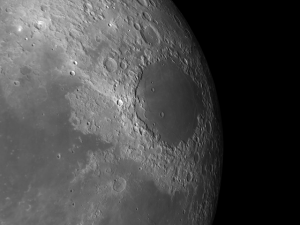The week of February 22-28 takes us from lunar Day 15 (full moon) through Day 20. The advantage of viewing the Moon in the days following full moon is that objects that were near the terminator on lunar days 2 & 3 will be seen more clearly because you’re not looking through low-horizon murk. The sunlight will just be streaming in from the opposite direction because it is now sunset on the Moon, and features will look slightly different.
This week we will highlight Mare Crisium (“MAH-ray cry-SEE-um” — the Sea of Crises), visible on February 24th. Early observers of the Moon referred to the large, dark, circular areas as “seas” because they thought that these were actually large bodies of water. The term stuck, and we still call them seas today.
Mare Crisium – the Sea of Crises
 Mare Crisium: [NE/H15] On Wednesday, you should be able to observe Crisium’s complexities more successfully than you did two weeks ago, particularly the high eastern mountain border. We tend to think of craters as comparatively small objects and lose sight of the fact that large lunar “seas” are the result of projectile impacts also. Basically, if it’s round, it’s a crater. Mare Crisium resulted from the impact of a large meteor 3.9 billion years ago. The event was energetic enough to leave a multi-ring imprint, parts of which we can clearly see tonight. Notice the ring features bending around Crisium on its north side. Particularly notice how Mare Anguis on the NE side of Crisium [G16] extends itself toward the west, passes below Cleomedes, and then dissipates at Tisserand. The Crisium basin appears elliptical, with its long axis running from north to south. This is an illusion due to the effects of foreshortening. Crisium actually is elliptical, but, contrary to what your eyes tell you, its long axis runs east and west. (If you have the Moon Globe HD app, you can see this for yourself. Do a search for Mare Crisium as it normally appears near the east rim of the Moon. Notice how it is elongated north to south. Now with one finger, rotate Crisium to the center of the Moon and it will develop its true east-west elongation.)
Mare Crisium: [NE/H15] On Wednesday, you should be able to observe Crisium’s complexities more successfully than you did two weeks ago, particularly the high eastern mountain border. We tend to think of craters as comparatively small objects and lose sight of the fact that large lunar “seas” are the result of projectile impacts also. Basically, if it’s round, it’s a crater. Mare Crisium resulted from the impact of a large meteor 3.9 billion years ago. The event was energetic enough to leave a multi-ring imprint, parts of which we can clearly see tonight. Notice the ring features bending around Crisium on its north side. Particularly notice how Mare Anguis on the NE side of Crisium [G16] extends itself toward the west, passes below Cleomedes, and then dissipates at Tisserand. The Crisium basin appears elliptical, with its long axis running from north to south. This is an illusion due to the effects of foreshortening. Crisium actually is elliptical, but, contrary to what your eyes tell you, its long axis runs east and west. (If you have the Moon Globe HD app, you can see this for yourself. Do a search for Mare Crisium as it normally appears near the east rim of the Moon. Notice how it is elongated north to south. Now with one finger, rotate Crisium to the center of the Moon and it will develop its true east-west elongation.)
======================
It is highly recommended that you get a copy of Sky and Telescope’s Field Map of the Moon, the very finest Moon map available for use at the telescope. It is available for $10.95 at www.skyandtelescope.com and on Amazon. All features mentioned in this blog will be keyed to the grid on the Field Map and will look like this: Plato: [NW/D9]
Credits:
Courtesy of Gray Photography of Corpus Christi, Texas
Lunar photos: NASA / USGS / BMDO / LROC / ASU / DLR / LOLA / Moon Globe. Used by permission
- Rupes Cauchy: A Best Known Fault on the Moon - July 22, 2024
- Moon Crater Schickard – Crater Floor has Stripes - July 15, 2024
- Moon Craters Langrenus and Vandelinus - July 8, 2024